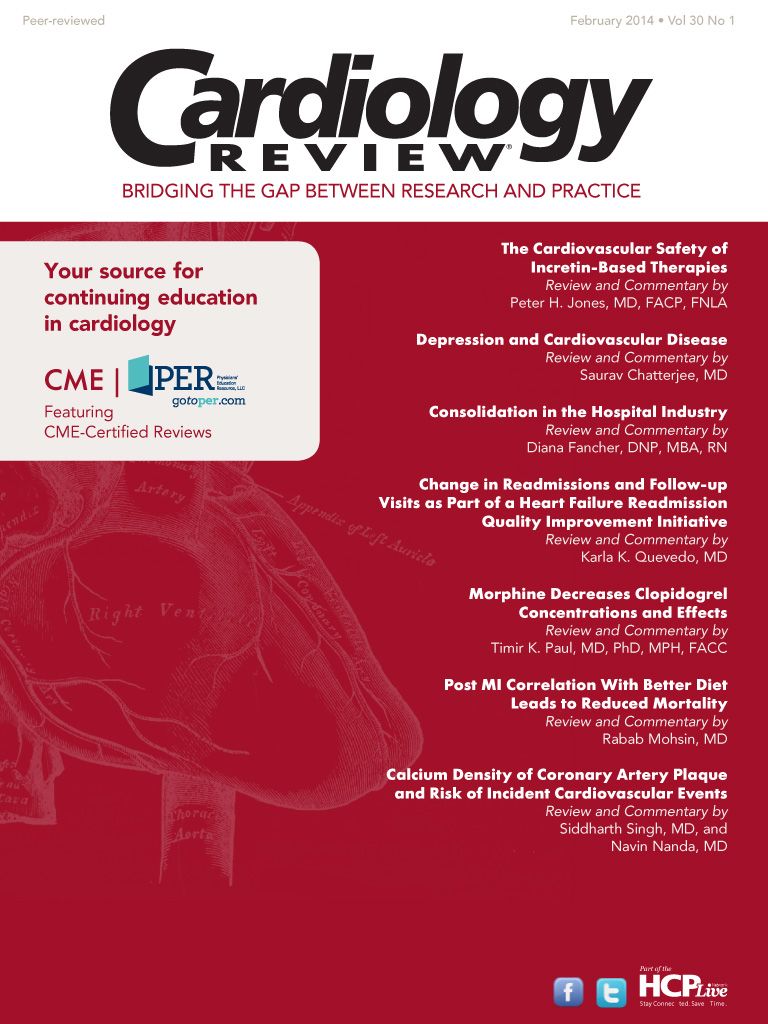Publication
Article
Cardiology Review® Online
Meeting Report: World Diabetes Congress
Five presentations from the World Diabetes Congress are highlighted, covering studies of long-acting Lantus insulin, affordability of care, DPP-4 inhibitors and heart failure in diabetes, brown versus white rice to reduce obesity and diabetes, and the converging pandemics of diabetes and tuberculosis.
World Diabetes Congress
Melbourne, Australia, December 2-6, 2013
T
he World Diabetes Congress is one of the largest health-related congresses in the world. Organized by the International Diabetes Federation, the World Diabetes Congress brings together over 12,000 delegates and more than 400 internationally renowned speakers.
Cardiology Review
In this issue of , 5 presentations from the Congress are highlighted, covering studies of long-acting Lantus insulin, affordability of care, DPP-4 inhibitors and heart failure in diabetes, brown versus white rice to reduce obesity and diabetes, and the converging pandemics of diabetes and tuberculosis.
Improved Version of Long-Acting Lantus Allows Improved Blood Glucose Control
R
esults of a Phase III study of Sanofi’s improved version of insulin glargine (Lantus) suggest that it is better than the older version of Lantus at controlling blood glucose levels and is associated with fewer nighttime hypoglycemic events.
The new insulin, known as U300, requires less frequent and lower dosing than Lantus, and provides a more consistent insulin release. U300 also lowered the incidence of hypoglycemic events at any time of the day across the 6-month study period.
In 3 other Phase III clinical trials, U300 met its goal by demonstrating similar blood glucose level control as Lantus in patients with type 2 diabetes who were not previously treated with insulin and were uncontrolled on oral medication, as well as in patients with type 1 diabetes already treated with insulin.
Sanofi plans to seek approval of U300 in the United States and Europe in 2014.
Affordability of Diabetes Medications a Concern
E
xperts in diabetes spoke at the World Diabetes Congress 2013 about the affordability of medications used to treat diabetes worldwide, calling for collective action by a range of organizations and groups to ensure that diabetes medications are made more affordable. The surge in diabetes cases around the world—with more than 80% occurring in low- and middle-income countries—has made this topic of particular importance.
Juan Jose Gagliardino, MD, of the Pan American Health Organization/World Health Organization Collaborating Center for Diabetes in Argentina, said that educating doctors, patients, and other health care providers was essential for good outcomes because medications alone can’t assure good health outcomes. He noted that half of all nations have less than $400/person/year to spend on diabetes; 42% of countries have less than $300/year and 20% limit their spending to less than $100/year per person. Dr. Gagliardino compared the cost of the most basic treatment regimen for type 2 diabetes (metformin and sulfonylureas, ACE inhibitor, and a statin, at a cost of around $264/ year), with the cost of substituting just one new medication for an older one—for example, substituting a dipeptidyl peptidase inhibitor for a sulfonylurea, which raises the cost to $1752/year. He said that a worldwide action plan was needed to increase national healthcare budgets and promote earlier diagnosis and treatment of diabetes to allow health goals to be met at lower costs. The pharmaceutical industry also needs to acknowledge that it has to work toward affordable new drug prices if more patients are going to have access to their newer treatments, he said.
Edwin Gale, MB, BChir (Cantab), FRCP, of the University of Bristol School of Clinical Sciences, United Kingdom, noted that 90% of insulin is branded, with just 3 companies controlling more than 90% of the global $16.7-billion insulin market. He said the time had come to change the situation to make a more equal playing field, and changing the way insulin is provided offers one of the biggest opportunities to cut costs. Dr. Gale said the price of insulin around the world can vary by 5000%, representing a huge profit margin for many companies. He believes that price transparency is needed for insulin costs in different countries. Furthermore, he said there is no evidence to suggest insulin analogues should be used rather than the human insulin that is now off patent but not preferred in developed nations.
Dr. Gale pointed out that generic availability of recombinant human insulin products—the biosimilars—is an important opportunity that should be fully explored.
Vigilance Recommended for T2D Patients at High Risk of Heart Failure if Taking DPP-4 Inhibitors
W
hile patients with type 2 diabetes (T2D) who are at high risk for or already have heart failure should not be prohibited from taking dipeptidylpeptidase-4 (DPP-4) inhibitors, they should be supervised closely for the first 6 months of therapy based on findings from new data from the SAVOR-TIMI 53 trial. The data suggest that patients with heart failure associated with the use of the DPP-4 inhibitor saxagliptin (Onglyza) appeared to occur primarily in the first 6 months of use of the medication.
Israeli researchers said that after 6 months the difference in hospitalization for heart failure was very minor and not significant. There was also no evidence that patients treated with saxagliptin had a more complicated course of heart failure while in the hospital.
Itamar Raz, MD, of Hadassah University Hospital in Jerusalem, said that the slightly increased risk of heart failure with saxagliptin is likely real and is probably a class effect, but the mechanism is not yet known. Future large-scale DPP-4 inhibitor studies are needed to get more information.
Dr. Raz said that if a patient with heart failure needs to take a DPP-4 inhibitor, he or she should be followed closely with frequent visits and regular sequential brain natriuretic peptide testing and renal function testing.
Eat Brown Rice Instead of White to Lower Rates of Obesity and Diabetes
I
n populations that eat a substantial amount of polished white rice, eating brown rice instead of white may help prevent and control diabetes, according to a new study presented by V. Mohan, MD, FRCP, PhD, DSc, FNASc, from the Madras Diabetes Research Foundation, World Health Organization Collaborative Centre for Non-Communicable Disorders in Chennai, India. This single change in the major dietary staple helps reduce blood glucose levels in every meal of the day, Dr. Mohan said.
Among adults in Chennai, white rice provides about half the daily calories and has been associated with risk for metabolic syndrome. In the study, 150 adults with a body mass index of 23 or greater and no known chronic diseases were randomized to a diet based on either white rice or brown rice for 3 months. The rice was consumed at least 6 days/week and was the major constituent of the typical meals. At the end of the 3-week period, there was a wash-out period of 2 weeks, and the participants changed to the alternative rice type. Food frequency questionnaires were used at baseline and 24-hour recalls were performed on a monthly basis; height, weight, and waist circumference were measured at baseline and the end of each month. Blood glucose and fasting insulin were also measured.
The 5-day mean glucose concentrations were about 20% lower among those consuming a brown-rice diet, and fasting insulin concentrations were 57% lower among those eating the brown-rice diet.
Dr. Mohan said his research team is now conducting a study in adults with prediabetes to see whether substituting brown rice for white rice will help prevent the development of type 2 diabetes.
Twin Threat: Converging Pandemics of TB and Diabetes
E
ighty percent of diabetes cases are occurring in the developing world, in low- and middle-income countries. People with diabetes are at higher risk of contracting tuberculosis (TB), experts say, because diabetes increases the risk for active TB two- to threefold, with the risk higher in those with poorer glucose control.
Anil Kapur, MD, from the World Diabetes Foundation in Fentofte, Denmark, said the biggest issue is primary TB. The two largest countries with the highest risk of endemic TB, China and India, are also the countries with the highest burdens of diabetes. He called the convergence of the epidemics a “syndemic.” Some studies suggest that as many as half of all those infected with TB in countries like India and China have coexisting diabetes, about half of which is undiagnosed.
People with both conditions suffer worse sequelae, Dr. Kapur said. When people with diabetes contract TB, it tends to affect the lower lung lobes, with pulmonary microangiopathy, and is more like TB cases seen in people with HIV infection. It takes longer to cure and distorts glycemic control, thus having a negative impact on some of the complications of diabetes. The risk of dying from TB in people with diabetes is about 4 to 5 times higher than in people with TB who do not have diabetes.
Dr. Kapur recommends routine screening of those with TB for diabetes because the number of TB cases needed to screen to find 1 diabetes case is generally very low, and it is not costly or difficult to do. In countries where TB is endemic, however, it is prudent that diabetes clinics do a symptom screen every 6 months.





